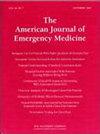Diverticulitis evaluation and management among United States emergency departments over an eight-year period
IF 2.7
3区 医学
Q1 EMERGENCY MEDICINE
引用次数: 0
Abstract
Introduction
Diverticulitis is a common reason for presentation to the Emergency Department (ED). However, as imaging options, risk stratification tools, and antibiotic options have expanded, there is a need for current data on the changes in incidence, computed tomography (CT) performance, antibiotic usage, and disposition over time.
Methods
This was a cross-sectional study of ED patients with a diagnosis of diverticulitis from 1/1/2016 to 12/31/2023. Using the Epic Cosmos database, all ED visits for acute diverticulitis were identified using ICD-10 codes. Outcomes included total ED presentations for diverticulitis, admission rates, CTs performed, outpatient antibiotic prescriptions, and antibiotics administered in the ED for admitted patients.
Results
There were 186,138,130 total ED encounters, with diverticulitis representing 927,326 (0.50 %). The rate of diverticulitis diagnosis increased from 0.40 % to 0.56 % over time. The admission rate declined over time from 33.6 % to 27.7 %, while the CT rate rose from 83.0 % to 92.6 %. Among those discharged, 90.4 % received an antibiotic, which remained consistent over time. Metronidazole (55.1 %) and ciprofloxacin (40.8 %) were the most commonly prescribed antibiotics, followed by amoxicillin-clavulanate (36.1 %). Among those admitted, most received either metronidazole (62.0 %), a fluoroquinolone (40.4 %), a third-generation cephalosporin (18.9 %), or a penicillin-based agent (38.1 %). Among both discharged and admitted patients, there was a marked shift to penicillin-based agents as the primary antibiotic regimen.
Conclusion
Diverticulitis remains a common ED presentation, with a gradually rising incidence over time. Admission rates have decreased, while CT imaging has become more common. Most patients receive antibiotics, though the specific antibiotic has shifted in favor of penicillin-based agents. These findings can provide key benchmarking data and inform future initiatives to guide imaging and antibiotic use.
八年间美国急诊科对憩室炎的评估和处理。
简介憩室炎是急诊科(ED)的常见病因。然而,随着影像学选择、风险分层工具和抗生素选择的增加,需要有关发病率、计算机断层扫描(CT)表现、抗生素使用和处置随时间变化的最新数据:这是一项横断面研究,研究对象是 2016 年 1 月 1 日至 2023 年 12 月 31 日期间诊断为憩室炎的急诊室患者。利用 Epic Cosmos 数据库,使用 ICD-10 编码识别了所有急性憩室炎急诊就诊患者。结果包括急诊室憩室炎就诊总人数、入院率、CT检查、门诊抗生素处方以及急诊室对入院患者使用的抗生素:结果:急诊室就诊总人数为 186 138 130 人次,其中憩室炎就诊人数为 927 326 人次(0.50%)。随着时间的推移,憩室炎的诊断率从 0.40% 上升到 0.56%。入院率从 33.6% 下降到 27.7%,而 CT 诊断率从 83.0% 上升到 92.6%。在出院患者中,90.4% 的人使用了抗生素,这一比例在一段时间内保持不变。甲硝唑(55.1%)和环丙沙星(40.8%)是最常用的抗生素,其次是阿莫西林-克拉维酸(36.1%)。在入院患者中,大多数人使用甲硝唑(62.0%)、氟喹诺酮类(40.4%)、第三代头孢菌素(18.9%)或青霉素类药物(38.1%)。在出院和入院患者中,青霉素类药物作为主要抗生素治疗方案的趋势明显:结论:憩室炎仍然是急诊科的常见病,随着时间的推移,发病率逐渐上升。入院率有所下降,而 CT 成像检查变得更加常见。大多数患者会接受抗生素治疗,但具体的抗生素已转向青霉素类药物。这些发现可以提供关键的基准数据,并为未来指导成像和抗生素使用的措施提供参考。
本文章由计算机程序翻译,如有差异,请以英文原文为准。
求助全文
约1分钟内获得全文
求助全文
来源期刊
CiteScore
6.00
自引率
5.60%
发文量
730
审稿时长
42 days
期刊介绍:
A distinctive blend of practicality and scholarliness makes the American Journal of Emergency Medicine a key source for information on emergency medical care. Covering all activities concerned with emergency medicine, it is the journal to turn to for information to help increase the ability to understand, recognize and treat emergency conditions. Issues contain clinical articles, case reports, review articles, editorials, international notes, book reviews and more.

 求助内容:
求助内容: 应助结果提醒方式:
应助结果提醒方式:


